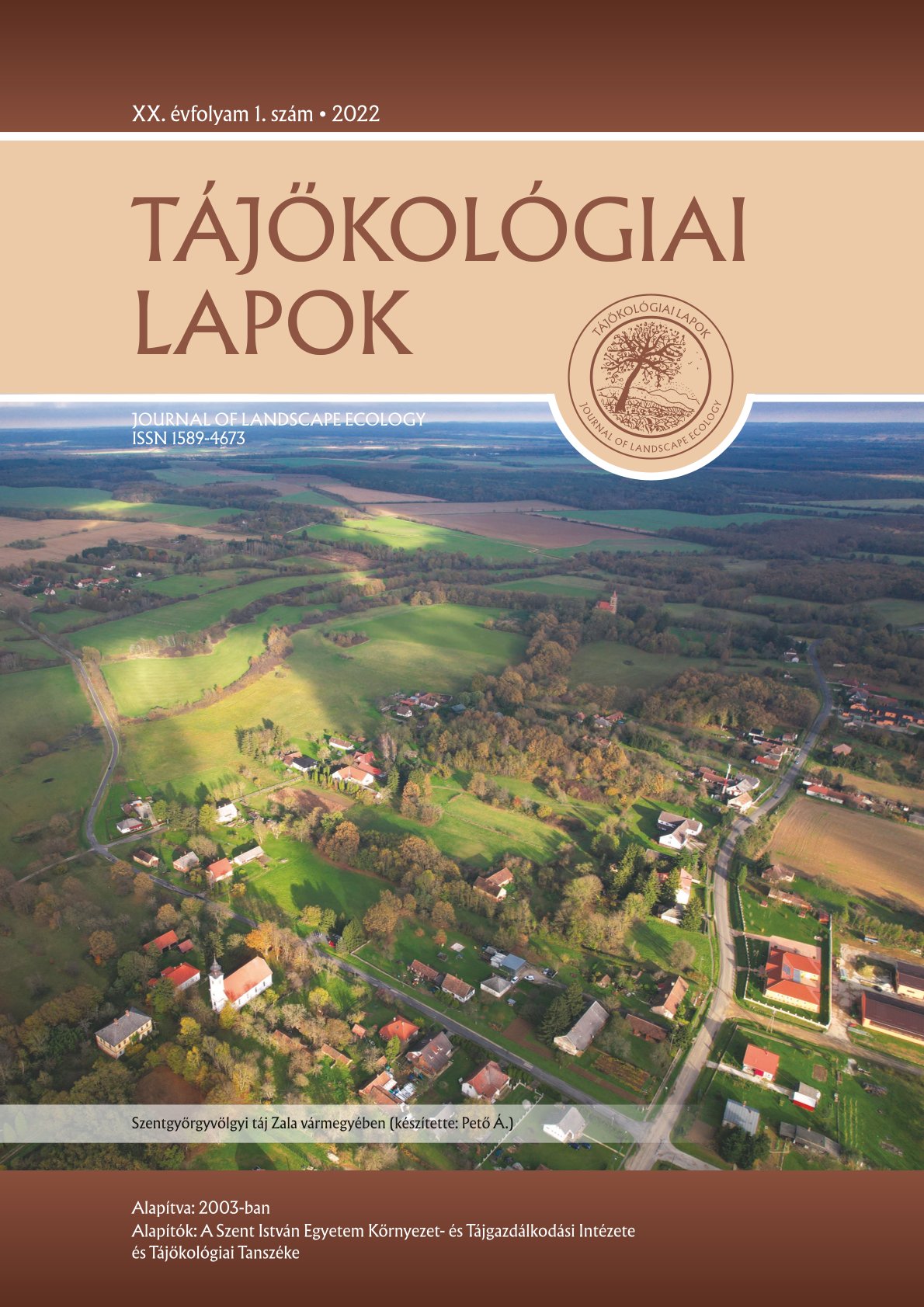Landscape-use history and vegetation of abandoned vineyards in the Karancs valley, Hungary
DOI:
https://doi.org/10.56617/tl.3380Keywords:
grape production, historical map, landscape management, naturalness, protected plant species, wine productionAbstract
Numerous recent studies have focused on botanical values and their relations with habitat conditions in light of landscape-use history. In the northernmost part of Nógrád County (Hungary), however, there has been no such kind of research, contrary to the southern areas of this county. Our aim was to explore the one-time vineyards of Karancsberény and Karancslapujtő villages in the northernmost part of Nógrád County, as well as to get to know the history of their landscape use, register the occurrences of protected and rare plants, and explore the condition of the habitats under succession after abandonment. Field investigations were done during the vegetation period of 2019 and 2020., in altogether 8 vineyard territories. We made a list of the vascular plants and the number of specimens in the case of protected plant species. We compiled landscape-use history information from various sources, such as historical and recent maps, statistics, literature sources, interviews with old local inhabitants, etc. The succession processes since the abandonment resulted in habitat patches with high natural value. Based on the nature conservation indicator values of vascular plants after Simon (based on the Ellenberg system), the ratio of species that refer to natural conditions overrides the rate of degradation-tolerant species everywhere, except for one area. There are almost no invasive alien species in the studied sites, except for a couple of specimens. The occurrence of seven protected (Adonis vernalis, Centaurea sadleriana, Dianthus deltoides, Linum hirsutum, L. tenuifolium, Ornithogalum brevistylum, Scabiosa canescens) and two other rare species (Chamaecytisus virescens, Thymelaea passerina) has to be emphasized. The current land management (grazing, and mowing in one site) helps the preservation of their values, but scrub encroachment dominates several parcels in lack of management, leading to the disappearance of some rare species.
References
Bartha D., Király G. (szerk.) 2015: Magyarország edényes növényfajainak elterjedési atlasza. Nyugat-magyarországi Egyetem Kiadó, Sopron. p. 329.
Beránek Á. 2008: Adatok a Heves-Borsodi-dombság és az Upponyi-hegyhát flórájához II. Kitaibelia 13(1): 34–45.
Bölöni J., Molnár Zs., Kun A. (szerk.) 2011: Magyarország élőhelyei. MTA Ökológiai és Botanikai Kutatóintézete, Vácrátót. p. 441.
Csiky J. (2004): A Karancs, a Medves-vidék és a Cerová vrchovina (Nógrád-Gömöri bazaltvidék) flóra- és vegetációtérképezése. Szerzői kiadás, Pécs. p. 451.
Csiky J., Sulyok J., Schmotzer A. 1999: Adatok a Salgótarján körüli oligocén kori homokkő flórájához. Kitaibelia 4(1): 55–63.
Csorba P., Ádám Sz., Bartos-Elekes Zs., Bata T., Bede-Fazekas Á., Czúcz B., Csima P., Csüllög G., Fodor N., Frisnyák S., Horváth G., Illés G., Kiss G., Kocsis K., Kollányi L., Konkoly-Gyuró É., Lepesi N., Lóczy D., Malatinszky Á., Mezősi G., Mikesy G., Molnár Zs., Pásztor L., Somodi I., Szegedi S., Szilassi P., Tamás L., Tirászi Á., Vasvári M. (2018): Tájak. In: Kocsis K. (szerk.): Magyarország Nemzeti Atlasza 2. kötet. Természeti környezet. MTA CSFK Földrajztudományi Intézet, Budapest. pp. 112–129.
Dedák D., Sulyán P.G. 2013: Felhagyott szőlők tájtörténeti és botanikai vizsgálata a Kelet-Cserhátban. Természetföldrajzi Közlemények a Pécsi Tudományegyetem Földrajzi Intézetéből 2(2): 23–33.
Dövényi Z. (szerk.) 2010: Magyarország kistájainak katasztere. MTA Földrajztudományi Kutató Intézet, Budapest. pp. 699–702.
Király G. (szerk.) 2009: Új magyar füvészkönyv. Aggteleki Nemzeti Park Igazgatóság, Jósvafő. p. 616.
Kiss G., Baráz Cs., Gaálová K., Judik B.(szerk.) 2007: A Karancs–Medves és a Cseres-hegység Tájvédelmi körzet – Nógrád és Gömör határán. Bükki Nemzeti Park Igazgatóság, Eger. p. 382.
Malatinszky Á., Mravcsik Z. 2013: Az Északi-Cserhát szőlőhegyeinek tájtörténete és természetvédelmi jelentősége. In: Muskovics A.A. (szerk.): Borkultúra és társadalom, visszatekintve a 21. századi Magyarországról. Agroinform Kiadó, Budapest. pp. 215–223.
Malatinszky Á., Mravcsik Z., Dedák D. 2014: Florisztikai adatok a Cserhát felhagyott szőlőiből. Kitaibelia 19(2): 260–266.
Mravcsik Z., Harmos K., Malatinszky Á. 2009: Felhagyott szőlők botanikai és tájtörténeti vizsgálatai az Északi-Cserhátban. Tájökológiai Lapok 7(2): 477–478.
Schneider M. (szerk.) 1971: Dézsma és robot. A jobbágyság helyzete a XVII. század végén a mai Nógrád megye területén. In: Adatok és források a Nógrád megyei levéltárból. Nógrád megyei levéltár és a Magyar Történelmi Társulat Nógrád megyei csoportja, Salgótarján. p. 29.
Schneider M. (szerk.) 1973: A török után. Az 1715. évi országos összeírás adatai a mai Nógrád megye községeiről. In. Adatok és források a Nógrád megyei levéltárból. Nógrád megyei levéltár és a Magyar Történelmi Társulat Nógrád megyei csoportja, Salgótarján. p. 27.
Shvoy M. 2006: Nógrád megye leírása (1874-1875). Nógrád Megyei Levéltár, Salgótarján. pp. 39–40, 51.
Simon T. 2000: A magyarországi edényes flóra határozója. Tankönyvkiadó, Budapest. p. 976.
Számel R. 2022: Botanikai és tájhasználat-történeti kutatások Balaton-felvidéki felhagyott szőlőkben. Tájökológiai Lapok 20(Suppl.1): 161–187. DOI: https://doi.org/10.56617/tl.3153
Vojtkó A. 2010: Növényzet. In: Dövényi Z. (szerk.): Magyarország kistájainak katasztere. Karancs. MTA Földrajztudományi Kutató Intézet, Budapest. pp. 700–701.
http1: http://floraatlasz.uni-sopron.hu/ (2020. augusztus)
http2: http://www.ksh.hu/docs/hun/xstadat/xstadat_eves/i_omn024b.html (2020. augusztus)
Downloads
Published
Issue
Section
License
Copyright (c) 2022 Malatinszky Ákos, Novák Eszter

This work is licensed under a Creative Commons Attribution-NonCommercial-NoDerivatives 4.0 International License.
A folyóirat Open Access (Gold). Cikkeire a Creative Commons 4.0 standard licenc alábbi típusa vonatkozik: CC-BY-NC-ND-4.0. Ennek értelmében a mű szabadon másolható, terjeszthető, bemutatható és előadható, azonban nem használható fel kereskedelmi célokra (NC), továbbá nem módosítható és nem készíthető belőle átdolgozás, származékos mű (ND). A licenc alapján a szerző vagy a jogosult által meghatározott módon fel kell tüntetni a szerző nevét és a szerzői mű címét (BY).












